 Abraham Lincoln
If given the truth, the people can be depended upon to meet any national crisis...
Abraham Lincoln
If given the truth, the people can be depended upon to meet any national crisis...
 Guildford news...
for Guildford people, brought to you by Guildford reporters - Guildford's own news service
Guildford news...
for Guildford people, brought to you by Guildford reporters - Guildford's own news service
The Eagle Eye: Civic Pride
Published on: 11 Oct, 2012
Updated on: 13 Oct, 2012
The Guildford Dragon NEWS is delighted to introduce a new monthly columnist, Mary Ellen Foley, who is going to look all things local through her American (Eagle) eye. You might be surprised, you might be amused, you might be horrified. This week you might even be educated, by someone from thousands of miles away, about our local civic customs….
Mary Ellen Foley writes…
In 1999, I arrived at Heathrow from San Francisco with a husband and a cat, but without return tickets. We thought we’d have a bit of a British adventure courtesy of a job transfer for him, and stay two or three years, but then we started talking about staying five years, then maybe a couple more than that.
At the ten year mark, I started writing a blog about British life that I thought would interest American Anglophiles, as well as disabuse some of them of their ideas that over here, we all live in thatched cottages, or we all live in elegant houses with servants (a la Downton Abbey), or we all live in London. (When we bought a house near Guildford, an American professor of English literature told me that by settling outside London, we were missing the experience of real English life.)
Today I find I’ve lived in the UK for 13 years, and traded thoughts of that return ticket for a British passport. My blog has picked up a fair few readers, and I find that a surprising number of them are British. Some like to see what the UK looks like from a different point of view; some read, I think, in hopes of catching me in a mistake; and some tell me they learn about things they’ve always taken for granted or never knew about their own country. (Did you know that the Windrush was originally a German ship? Or that in addition to bagging Munros (that is, climbing Scottish peaks over 3000 feet high), climbers bag Corbetts, Donalds, and Grahams? And everybody seems to like kibbitzing about the way Americans and Britons use the English language (Kibbitz: an American word borrowed from Yiddish, meaning “to put forward your opinion informally, though you have no expertise and nobody asked you”.)
I hope you’ll find my columns entertaining as I turn my American-adapted eye on Guildford at the invitation of Martin Giles, The Guildford Dragon NEWS publisher. We’re starting today with one I prepared earlier: a look at the civic procession last May, a subject made timely again because Guildford’s dignitaries will process in all their regalia to Holy Trinity on Friday, October 12, this time for the service to open the judicial year.
You might have read in The Guildford Dragon NEWS recently that the council no longer records in the minutes whether aldermen and freemen attended; presumably the council didn’t think that those on whom the borough has bestowed these honours would mind, but that’s not how it turned out.
A small matter? Maybe, but it raised the question of whether freemen and aldermen would be welcome in future civic processions. The Council says it’s only a misunderstanding and there’ll be no change in the line-up at civic processions, but in case these honourees are to become endangered species, you might want to be there in the High Street on Friday to get a glimpse before they’re gone. But can you tell an alderman from a freeman by the colours of their robes? If not, please read on.
Civic Pride
On a recent visit to the US, somebody asked me if I travel around Europe much now that I live here, and I said I didn’t, which just goes to show how your yardstick for making such measurements can be altered by familiarity.
Travel much? Not me—I’ve only been to Sweden (twice), France, the Netherlands (twice), Spain, and Ireland (three times) since moving to England–plus India, though it’s not in Europe. And our travel within the UK is also European, isn’t it? We’ve been from Land’s End to John O’ Groats (US equivalent: coast to coast).
But with all that going on, I haven’t taken as much notice as I should of the history and traditions of the Borough of Guildford, an area that includes the town of Guildford and outlying villages like mine, and the local government that operates here. Guildford was extremely pleased to be the last stop for the Olympic torch before its final run to London, and the host of the final stage of the Tour of Britain cycle race. So now, when everybody’s taking a little more pride in the place, seems a good time to tell readers something about the Borough.
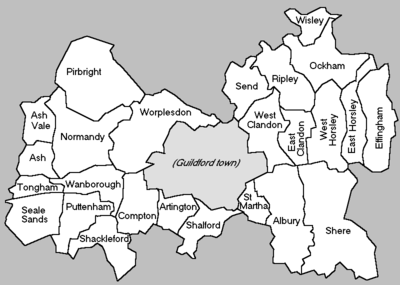
The civil parishes that make up the Borough of Guildford, with Guildford itself as the grey blob in the middle
Each May, borough councillors elect one of their number to be the mayor, hold a Mayor Making ceremony at the Guildhall to make the appointment official, and kick off the new mayor’s year in the job with a civic procession to Holy Trinity Church, which seems as good a place as any to begin.
The crown first gave Guildford the right to elect its own mayor about 650 years ago. There’s no telling how long local dignitaries have been putting on their full ceremonial regalia and processing from the Guildhall to Holy Trinity Church, but like most local worthies you’ll see around the UK, their costumes seem to have been been frozen in the 1700s. As figures wearing tricorn hats (for women) or bicorn hats (for men) emerged from the Guildhall, a little girl near me gasped and sang out “Pirates!”
First came Neighborhood Superintendent Darren McInnes, representing the Surrey Police, though he was spared the pirate get-up, and wore an ordinary modern uniform. A neighborhood superintendent assists a chief superintendent, of which Surrey has three; Guildford is in West Surrey, Sup. McInnes’ territory.
Next came David Peters, town crier and beadle who, as he wasn’t crying, I must assume was beadling. Mr. Peters’ father, grandfather and great-grandfather all held the same office; his family has had the town crier-ship in Guildford sewn up for over 100 years. You can click here for an article about him, and a photograph of the three bells he uses in his town crying (professional tip: don’t wear gloves; you might drop a bell and ruin it).
A beadle, by the way, protects the mayor, among other traditional duties that aren’t perhaps needed so much today, including going into pubs on Sundays to find out who skips church. Mayors had Common Criers working for them by at least the early 1300s, although the Ancient and Honourable Guild of Town Criers, to which Mr Peters belongs and which sounds wonderfully medieval, was only established in 1978.
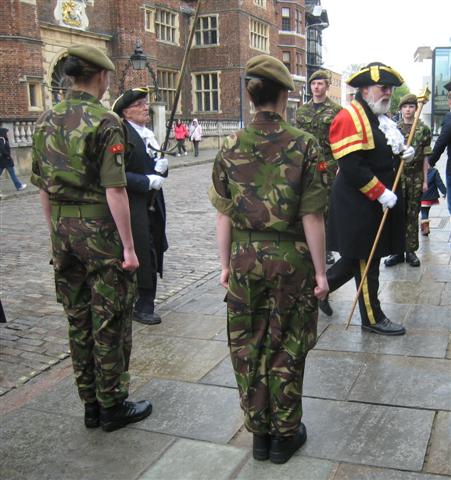
The town crier and sword bearer enter the churchyard through an honor guard of military cadets. The sword is so long, I didn’t manage to get a photo that includes its whole length.
A sword-bearer followed, carrying such a long sword that I’m not sure I got a single photo of him that includes the whole length of the thing. It’s a 16th-century German zweihander, made to be used by a horseman who, holding it in both hands, would strike down against the foe on either side (presumably being very careful of the horse’s ears). The sword isn’t an official part of the borough regalia; staff at the local museum tell me that they carry it in the procession just because they happen to have it, though nobody knows where it came from or why it’s there.
The procession also had two mace-bearers for the simple reason that Guildford, happily and unusually, has two ancient ceremonial maces, including one of the finest of only 15 civic maces in the UK that date back to the 1400s. (Guildford’s back-up mace only dates back to 1633.) Maces are symbolic clubs; mace-bearers originally would have carried serious workaday clubs and would have used them to clear the road of rabble. When not carrying a ceremonial mace, one of the mace-bearers doubles as the mayor’s chauffeur.
Mrs Karin Sehmer, seen here in her green uniform, with medallion of office and traditional plumed hat, is the current High Sheriff of Surrey. At one time, sheriffs had real law enforcement jobs as the king’s highest representatives in their counties; now the office is honorary, but the monarch still appoints her High Sheriffs—the Lord Lieutenant of the county gives the queen a list of three nominees, and she chooses the person for the job by pricking the name with a brass bodkin. No, I didn’t make that up. And a bodkin, in case you weren’t aware, is something like a poniard. If you’re interested in such wonderful and archaic English words, you may enjoy knowing that the High Sheriff’s address is the Shrievalty Office—the word sheriff comes from shire (county, roughly speaking) and reeve (a high-ranking official).
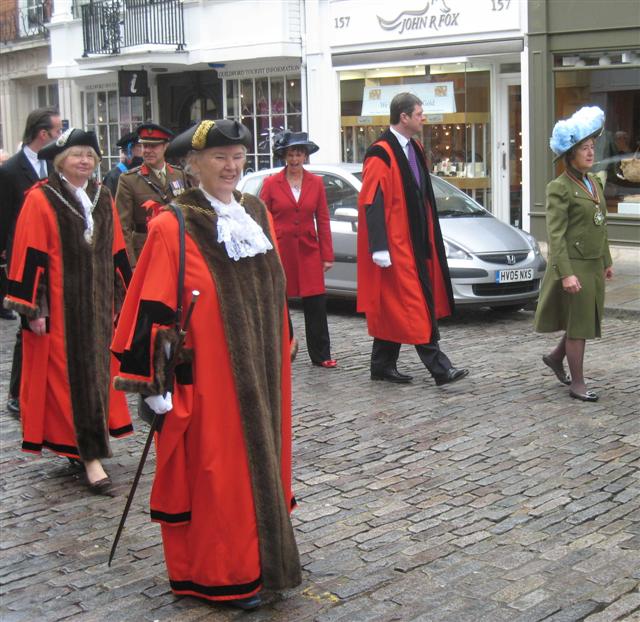
The Mayor of Guildford in the foreground (with red robe, gold chain, and staff) with the High Sheriff of Surrey (in green uniform with plumed hat). Behind the mayor is the Deputy Mayor; the tall fellow behind the High Sheriff is the Chief Executive (formerly Town Clerk)
The mayor has to make do with a decidedly less macho address: official correspondence comes to the Mayor’s Parlour. Our new mayor is Councillor Mrs Jennifer Jordan, seen here in a scarlet robe with squirrel-fur trim. The staff she carries is supposed to have been given to the Borough by Elizabeth I, and is not a canonical part of a UK mayor’s outfit. It’s made of campeachy wood, imported from Central American for dying (and so might have been donated by someone connected with the wool trading that made Guildford prosper in those days). Its silver top is engraved FAYRE GOD. DO JUSTICE. LOVE THY BROTHER. 1565. but a town official confided that one former mayor was found to be carrying it upside-down, bashing the inscription on the stones of the street.
A British mayor usually wears a gold chain of office; in these photos, the new mayor’s white frills almost hide the chain and the badge of office that hangs from it. Guildford’s chain, being old and historic, is less showy than some (there’s a picture of mayors with more modern chains, below).
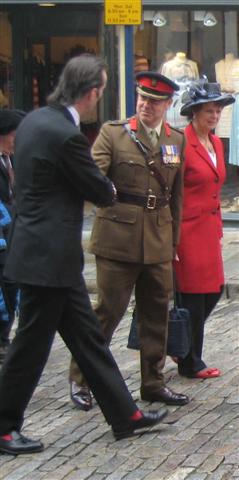
Lord Onslow, the High Steward, greets Colonel Crowley, in the company of Guildford’s MP, Anne Milton
A member of the Onslow family, local landowners of historical importance, donated the solid-gold badge in the 1600s, and had the gumption to put his own arms on the reverse in defiance of the law against such self-aggrandizing. King James II prosecuted him for the offense, and while the charges were eventually dropped, the town’s mayors didn’t use that badge again until James II died.
Next in procession comes the chief executive (formerly known as the town clerk), who walks beside the deputy mayor. They’re followed by a row of three: Anne Milton, the Member of Parliament for Guildford; Colonel Patrick Crowley of the Princess of Wales Royal Regiment, the only regiment to have the freedom of the borough (I’ll explain that in a future post); and Guildford’s current high steward, Lord Onslow, that is, Rupert Charles William Bullard, 8th Earl of Onslow. The High Steward, like the High Sheriff, used to have a role in local law enforcement but now holds only a ceremonial position; the council invited the current earl to take on the job when his father, the previous High Steward, died last year.
The highest honour the Borough can bestow is that of Honorary Freeman, a title which in most towns and cities comes with privileges, such as the right to carry your sword unsheathed, or to herd your sheep and cattle over bridges without having to pay the toll. I’ve heard of a town whose councillors thought it’d be fun to get a flock of sheep and have the new freemen herd them over a bridge, which they did, but when they got to the other end, the sheep scattered through the town and had to be rounded up, which took some doing.
The freemen wear black robes with blue trim; in the photo with them, in black with red trim, is Honorary Remembrancer Matthew Alexander. The title is so wonderfully medieval, so redolent of history and old books, it almost gives me cold chills—so I was disappointed to find that it only dates back to 1933. The honorary remembrancer keeps track of important events and presents the council with a bound book containing his report at the end of the year. These dignitaries wear, instead of 18th-century tricorns and bicorns, what’s known as a Tudor bonnet, an academic-style cap used by many universities here instead of mortarboards. (My husband is about to get his PhD from a university where they wear Tudor bonnets, and just so he doesn’t get bigheaded I’ve been calling him Dr Squashy Hat.)

Some of the visiting mayors, wearing their ornate chains of office over ordinary business suits (which is how you usually see British mayors)
Guildford invites other mayors from jurisdictions within Surrey to join the fun, too. Their showy chains seem a bit nouveau next to Guildford’s smaller, finer version. Mayors are of course welcome to come and go from each other’s towns like anybody else, but if they visit in their capacity as mayor of another jurisdiction, they must apply to the local mayor for permission to wear their chains. There might have been serious issues of protocol and insult at one time, but these days the custom is just a courtesy, and saves the embarrassment of having some mayor open the newspaper and find that something official had happened in the area (the British might say on their patch) without their knowing.
The aldermen, in red robes, follow the mayors. Alderman is also a title conferred by the Borough Council as an honour; it’s usually given to former mayors or councillors for their long service. These councillors themselves follow, in black robes, and are in turn followed by couple of local magistrates in modern business clothes. (Like the councillors, aldermen, freemen and Surrey mayors, they’re all invited to participate, but they don’t all participate every time.)
Bringing up the rear, you can just see the blond head of Civic Secretary Kate Foxton, to whom I’m very grateful; Kate looked over my photos to identify all the people for me, which would have been an even longer task at one of the other two civic processions of the year; in October, the procession for the opening of the judicial year includes all the judges and magistrates, and in November, in the procession for Remembrance Day, officers, soldiers, and cadets march as well.
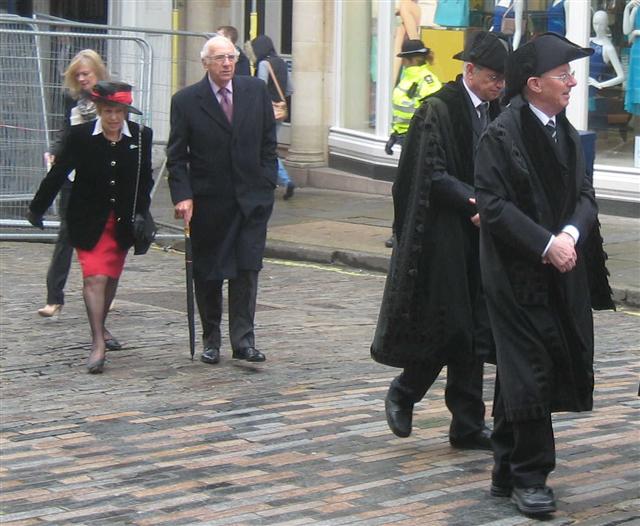
The last few borough councillors, followed by magistrates and, barely visible, Civic Secretary Kate Foxton–my apologies for not having a better photograph!
With Old(e) World(e) pageantry like this on my doorstep, why would I need much travel to the continent? Besides, people here don’t think European travel is exotic, but those trips I make to the US every year or so, now—that’s what my neighbors call real travel.
My thanks to Civic Secretary Kate Foxton, Guildhall tour guide Jill Buist, Borough Hospitality Officer Charles Robinson, and Guildford Museum staff member Mary Alexander.
All photos by Mary Ellen Foley; the map of civic parishes in the Borough of Guildford is taken from Wikipedia©.
Recent Articles
- ‘We Need To Get This Right,’ Says Coroner at Sara Sharif Pre-inquest Review
- Letter: This Article Is a Wonderful Reminder of the Magic in Our Backyards
- Another Housing Revenue Account Overspend Revealed at GBC
- Dragon Review: A Comedy of Errors and A Company of Rascals – Yvonne Arnaud Theatre
- Letter: The Question Is – What Format Should Guildford’s Representation Take?
- Letter: No One Would Notice if Local Government Were Abolished Tomorrow
- Highways Bulletin: Guildford Trial Paves the Way for Greener Roads!
- Mayor’s Diary: July 20 – August 3
- Insights: The Devil Remains in the Detail of this Sorry Mess of a Bill
- GBC Set to Approve a Public Consultation on Forming a Town Council



Search in Site
Media Gallery
Dragon Interview: Local Artist Leaves Her Mark At One of England’s Most Historic Buildings
January 21, 2023 / No Comment / Read MoreDragon Interview: Lib Dem Planning Chair: ‘Current Policy Doesn’t Work for Local People’
January 19, 2023 / No Comment / Read MoreA3 Tunnel in Guildford ‘Necessary’ for New Homes, Says Guildford’s MP
January 10, 2023 / No Comment / Read More‘Madness’ for London Road Scheme to Go Ahead Against ‘Huge Opposition’, Says SCC Leader
January 6, 2023 / No Comment / Read MoreCouncillor’s Son Starts Campaign for More Consultation on North Street Plan
December 30, 2022 / No Comment / Read MoreCounty Council Climbs Down Over London Road Works – Further ‘Engagement’ Period Announced
December 14, 2022 / No Comment / Read MoreDragon Interview: GBC Reaction to the Government’s Expected Decision to Relax Housing Targets
December 7, 2022 / No Comment / Read MoreHow Can Our Town Centre Businesses Recover? Watch the Shop Front Debate
May 18, 2020 / No Comment / Read More



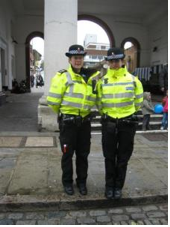
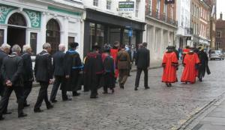
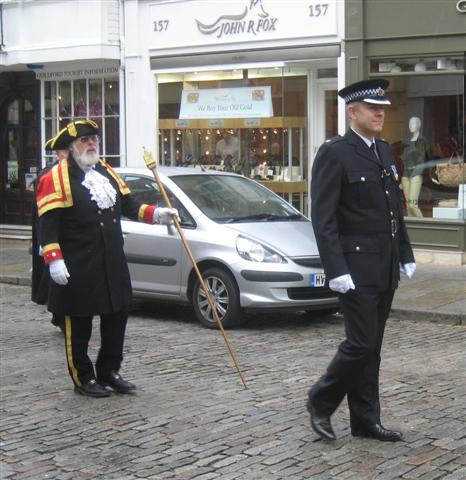
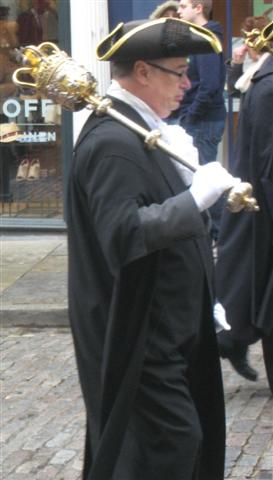
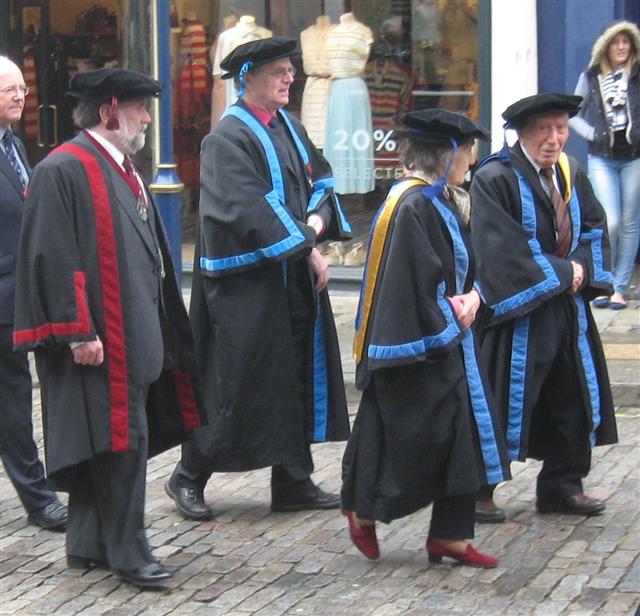

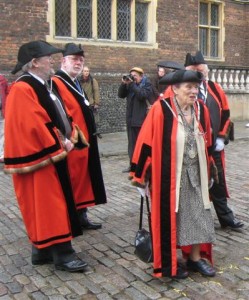



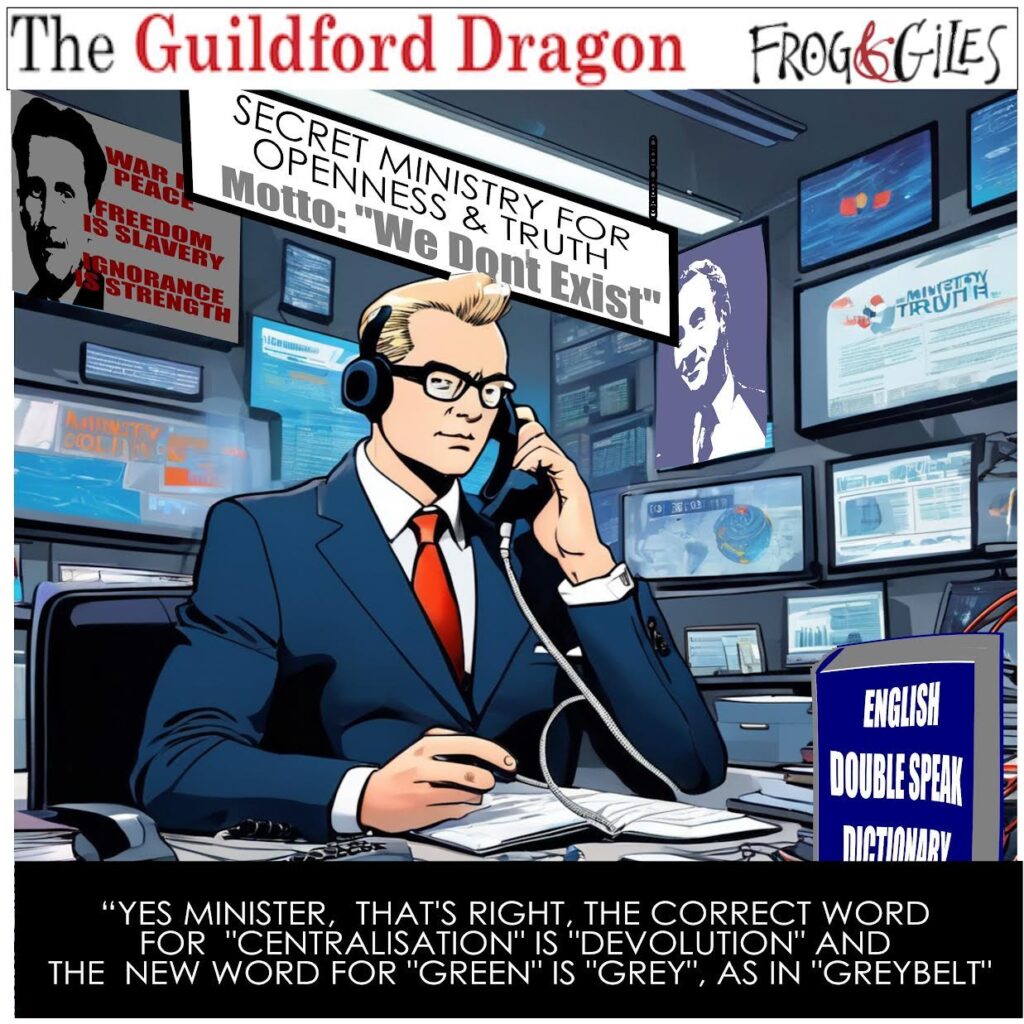




Recent Comments